Hyper-Stimulation (FMP)
- Ali Gray

- Feb 25, 2016
- 12 min read

For my final major project I will be focusing on my hyper-sensitive state; I aim to create a sensory simulation in order to communicate to others what it's like to be hyper-sensitive. By this I'm referring to my jumpiness, being easily startled leads to an anxious state, known also as 'fight or flight' response. This is a physiological reaction that occurs in response to anything that is percieved as a source of harm. An example being animals hunting each other, the prey will decide in a split second to fight their predator or flee.
This as you can imagine causes great distress as I feel instantly frightened for my life from minute stimulus. If you drop a pen next to me I may jump out my seat or even scream. This has only properly developed in the last year or two and I realsie it's linked to my level of anxiety which can be enhanced by factors in my enviroment, for example crowding and high noise levels. However sometimes I can be tipped over by something seeminlgy insignificant; yet leaves me feeling on edge, nauseas and shaky. For example someone hit me with their bag getting off the train yesterday and I jumped aggressively and felt sick and uncomfortable for hours.
In order to create a simulation; I firstly need to investigate sensory triggers that I am most sensitive to, I initially feel that sound is the main trigger as even someone raising their voice by an octave it seems like can startle me. I've noticed especially recently I'm also set off by visuals, in particular changes. So i noted that a computer pop up with no sound made me "AHH" the other day. I will post my recordings; I aim to take note every time I jump of the triggers as well as the environment and any other emotional or situational factors.
Zimoun Installations
I love the immersive installations, the one with the ceiling of fans angled at certain points and the wall of speakers that the audience have to pick and play, by pulling back the lid that encloses each speaker. Fo rmy installation however I don't want to allow the audience to have any kind of choice. The point is actually to enduce them into a state of hyper-sensitivity through immersion of the senses.
"ALI STOP" "surely it's gonna give you a heartattack" "I'm scared that I'm gonna have to call 999"
This is a recording of me jumping, watching a typical 'jump out of your skin, never sleep again JUMP SCARE WARNING' video which was really stresful to watch, however this day I felt particularly happy as I got two Uni offers, hence why I realised I'm able to laugh off my startle and laugh while jumping. I noted that I still felt the physical side effects (heart racing, sweating, tight chest etc.) of fight of flight but it was very temporary; unlike other experiences where I've left feeling of edge, nauseas and paranoid for minutes, even hours.
So through my record diary I've concluded so far that my 'jumpiness' very much depends on my mood. My mood can be affected by many factors also like the weather as I have seasonal affective disorder (SAD) as well as physcial enviromental factors due to my social anxiety. Things can include:
- big groups of people, as I feel lost and more pressured
- Infrequent noises: I'm more likely to jump at random noises in a quiet classroom than I am a loud concert as the noise level is constant
- On Public transport (smaller spaces, packed in with strangers)
This last point I've also realised is interesting as every time I'm on a bus in particular and it juts backwards and forwards I get really angry at myself as I sway this way and that. I'm trying to understand why this is but I've noticed every time it does happen, I feel anxious and like I'm taking up too much space; therefore its worse when I have more luggage with me. Perhaps it's the claustrophobic element, or the fact I'm with strangers or just annoyed at bouncing around carrying loads of stuff, but I will keep recording to try to get to the bottom of it.
Itching
I've also noticed (relevant to the video also) that I'm an incredibly itchy person. My skin crawls and feels hot and itchy. I've had skin problems and mild psoriasis on the back of my neck before but only now have I looked into it or considered it was in any way linked to my anxiety. I will record this, on video to add to my final video collage.
"A common cause of itching is psychological brought on by stress or other emotional problems. The skin is the largest organ on your body and anxiety attacks this organ with an irritating itch. Not only that, but stress can aggravate other skin problems such as eczema and psoriasis." (Anxietyboss.com)
Documentation






Here's a sketch I did when I was extremely anxious in my friends bedroom. Drawing calms me down and helps me to focus, I get tunnel vision in this state which ironically is helpful. I feel like I draw more sporadically and get easily distracted, switching between different techniques and mediums. Similar to Anatoly Grashchenko’s randomly generated segments of posters, however the collage is set.
I really love the movement in Anatoly Grashchenko's pieces and want to incorporate this glitchy effect, particularly with the constant change of my heart rate with bmp in the top corner, I'd quite to experiment also with glitchy transitions of takes.


Anatoly Grashchenko
Heart Rate

I compared my resting heart rate to my heart rate after I jumped, I was shocked to discover my heart rate jumped up by 59bpm. This was a particularly aggressive jump as somebody screamed right by my head, purposely to frighten me, but without me knowing.
Simone Cutri

I love Simone Cutri's method of evaluating the context, by redesigning subtitles to redefine the relationship between text and image. He furthermore uses eye tracking technology to test the cohesion of subtitles placement and readability. I will not be using subtitles, however I find it useful to looks at how the visual language and audio can be used to enhance the other. The placement of the subtitles are dotted around the screen as opposed to them being fixed at the bottom of the screen. I will hope to use surround sound to create a more immersive effect, but similar to this I don't want the audio (although in this case visual transcript) to be stationary. Mimicking the state of hypervigilance state I experience of constantly scanning the environment and being on high alert, hopefully by surrounding the audience with surround sound they will experience what I feel constantly.
Interview with Physcotherapist: Anxiety & Hyper-arousal
Today I interviewed a Physcotherapist to get a more professional perspective. I immediately noticed she referred to what I called hyper-sensitivity/stimulation, hyper-arousal. She explained any kind be used, as well as hypo-arousal; this refers to a 'freeze' or 'act dead' response. I learnt so much from this interview, it was also really strange to see Jackey again as she helped me to alleviate my anxiety, however she obviously couldn't disclose information personal to me.
She confirmed my findings that mood affects hyper-arousal, noting self esteem and anxiety "feed into each other".
Fight or Flight Response I learnt is broken down into: fight flight or freeze, freeze being physical emobolisation, in evolutionary terms this refers to animals playing dead in the hope either the predator won't want to eat dead prey, or that it'll be less painful to be eaten when their muscles are relaxed.


* PTSD- Post Traumatic Stress Disorder
It was also interesting to know about PTSD, after the interview she explained to me that it doesn't necessarily refer to a significant traumatic event such as war which I had initially assumed. PTSD can in fact be accumulative, for example a stressful upbringing, constant self doubt and esteem issues and those who are prone to anxiety may go on to develop PTSD.
I found this incredibly insightful and offered great explanation as for years I have battled with personal issues and self doubt and the increase of my anxious state seems to correlate. This may explain my developing state of hyper-arousal and I feel this interview has brought light to the real reasoning behind my condition.
MacEwan Hughes- What's Going On Here?
I found this video piece incredibly insightful. Although I am in no way comparing my acute form of PTSD with that of a war veteran, I found the process of matching up juxtaposing imagery interesting. The forced comparison of say a bird and a fighter jet plane highlights how even harmless, beautiful objects/ beings can be perceived in a warped way, everything is a constant reminder of the individuals trauma.
I aim also to use this method of combining seemingly innocent, typically 'calming' scenery with other sensory stimulus that doesn't seem to fit. Through this I will communicate how regardless of how small or beautiful stimulus is, I can easily be triggered to jump and my constant fear of the unknown, regardless often of my surroundings and the lack of threat. Such a small noise or movement can trigger fight of flight and similarly to 'What's Going On Here' where the audience is forced to link the two visuals, I hope to marry ill fitting stimuli and communicate my fear, which in many cases can ruin your experience of specific environments.
Video & audio edit experimentation
I've been constantly recording sound and visuals that may instigate a state of panic; train doors squeaking, babies crying and contrasting visuals so as to highlight that even in a typically 'peaceful' environment/ situation my anxiety can still flare up, especially as my mood plays a large part in my levels of anxiety, which can be random and triggered by minor incidences.
I plan to go to Portsmouth over the weekend and record the sunset by the beach and sights from high rise buildings to simulate a peaceful environment, but juxtapose it with distressing/ chaotic imagery of public transport and exaggerated minor sounds (like a pen dropping) so as to make people jump.
I will be using my old video camera which has a grainy effect as its poor quality, metaphorically representative of the nightmare like state anxiety can create, where I get tunnel vision, feel disconnected from the rest of the world and often cannot communicate properly and forget social conventions as I start to panic.
Portsmouth
Going to Portsmouth was incredibly useful as I gathered lots of visuals on my camera, with it's grainy quality I could record and visually represent my disconnected anxious state. It was incredibly beautiful at sunset meaning I could really capture a tranquil scene, perfect for my video as a juxtaposition to the audio and visuals I plant to record of my bodily reactions to anxiety.
Here are some screen shots of the videos I took throughout the day, wondering round the whole of Portsmouth.
A place I got really good shots from was a place called Hot Walls, we could overlook Portsmouth and South-sea. The most fascinating part I found to be the entrance to the towers, brick tunnels with arches and windows, peeking through to the sun setting on the sea. The contrast between history, nature and machinery was an interesting collage that I didn't even have to edit. The physicality's of the scene mimicked the complexities of the mental state experienced during fight or flight, the bright lights flashing through the turrets' windows, as I walk past made me feel like a 'rabbit in the head lights'. The scaffolding enclosing the historical towers I felt symbolised the chaos and suffocation felt physcially during fight or flight.
Editing
With all the collated visuals and audio clips I've collected so far, I've started to merge them together, edit them with layers, editing opacity and ducking sound levels and well as altering sound effects and speed.

Contextual Reference
Time Code (2000)- Mike Figgis
This film uses four seperate takes running continously, showing different perspectives of situations, following a group of people. This film looks into human interaction and I love the process of combining and contrasting. (see further details in sketch book)
I also experimented with this split screen process, however preferred for the majority of my video to use the green screen/ opacity effect as you can obviously see the whole image of both videos, but it also exaggerates the link between physical reactions and stimulus. For this clip however I love the continuity of dark tones and the left shows my eye at the end of a long night, my make up smudged, and glitter comparable to the bright street lights below in the right clip. A direct visual metaphor for what the night has done to me.
This outcome is similar also to that of 'What's Going On Here?', which holds the fascinating concept of audio comparison, however I've used the split screen as a visual comparison and unlike the form of PTSD MacEwan Hughes focuses on, my hyper-arousal doesn't recognise certain sounds/ visuals as something of actual threat, the threat that I fear is irrational, I have no reason to believe when I jump I will be harmed or die, yet I have taught myself since birth to react this way. Accumulative PTSD I didn't even knew I had has caused this fear.
Projection
Obviously the video is at early stages, but I was testing out how it would look projected onto the wall, I'm thinking I'd ideally like it to be in a small darkened space so may think about creating some kind of cave with sheets. The figure in the top left hand corner I will adjust frequently as its representative of my heart rate. I really love the process of projecting as it creates a more immersive experience rather than a small screen, I feel this would be enhanced if it were presented in a smaller darker space as the idea would be for an individual to go in by themselves and be immersed in the surround sounds and only visuals being the video; similar to the tunnel vision, a physical response to anxiety.
BPM- Typography

from Dafont.com (see typefaces and credits in sketchbook)
I've been testing out different fonts to use for my heart rate that will be featured in the top left hand corner of the screen, changing as my heart rate does. I've borrowed a blood pressure monitor that I will film myself using and edit into my video. This will help me get accurate readings that will change as I watch the video back myself, to keep the heart rate in sync with the video.
I've decided to stick with the top typeface as it mimics medical recording typefaces which I was going for, as I want it to appear to be the font featured on the blood pressure monitor.
Blood Pressure Monitor
I attached the blood pressure monitor to myself and recorded the results. Unfortunately there was no way of transferring the results to my video, so I had to input the titles into iMovie manually, with each clip being 0.5 seconds long this took a long time and it was frustrating I couldn't have the data transferred immediately to the video or even my computer as the software wasn't compatible, regardless of what software I downloaded in an attempt to get the monitor to display on my laptop. However even if I had managed to do this I'm unsure there's any way possible I could've had this displayed on iMovie without having to type it all in as titles. Nevertheless I was pleased with the outcome of the takes, and especially with the piercing sound of the velcro.
I just recorded my pulse and used this data not my SYS and DIA (systolic and diastolic).
I do wish the inflation of the sleeve was obvious as it's not really visible at all and would've helped emphasise some form of restraint.
While recording my results I experimented with heavy and irregular breathing patterns and whilst filming watched parts of my own video to induce a stress response. I was suprsied to see my reading ranged from a resting heart rate of approximately 72 bpm all the way up to 151 bpm.
Surround Sound - extra audio layer
I got my friend and music producer Ben Bien to help me record surround- sound audio, he told me that unless I used 5-7 speakers I couldn't achieve the desired effect so I now need to get some sound cancelling close back headphones for the exhibition as this will allow the sounds to travel. The microphone we used was a RODE NT-2 connected via a focusrite saffire 24 DSP, and used Logic music editing software.
We recorded :
glass bottles clinking, biscuit tin being opened, plates being piled, glasses case closing, me breathing (alternating pace), a lighter sparking, "sorries", door closing and my high pitch falsetto sing/scream as well as the phone ringing.
We also re-recorded the sound of the siren and redirected the sounds to circulate the microphone, by playing the recording off my phone and moving it around the microphone so that when played back it will sound as if the sound is coming from all around the listeners. I used the same technique when recording my breathing and moved closer and further away sporadically as well to intensify some of the breaths. This sounded particularly eerie and was my favourite part, I think it works really well and is edited into the video as the Psychotherapist explains the physical symptoms of heavy or uneasy breathing and ends with a flashed image of the sun with inverted colours.
Ben was so helpful, although I already had my audio track with sounds of trains, small jumpy sounds and a few "sorries", Ben helped me add another layer that really enhances the immersive experience of the piece and he helped me realise the way I could achieve this: through headphones. We played around with existing noises by separating them from the backing track, enhancing them and making them travel, using Logic software as well as manually using the microphone.
Final Video
Exhibition Set-up


Gonzalez Haase
I'm hoping the projector will be available however apparently there's only one available. If not I'll have to use a small old television I have which won't create the transparency however either way I want to create some kind of viewing booth/ cave, so that one person at a time experiences the simulation, the dark small space should create a sense of claustrophobia and enhance the visibility as well as exaggerate the surround sound audio, coming from all around you in the dark is bound to be very unsettling. I want to use a wooden stool I had when I was a child to emphasise the link of how we develop and learn certain behaviours as we grow up, as the psychotherapist explained to me in regards to accumulative trauma.
Immersive Box Plan

Before black sheet is attached:












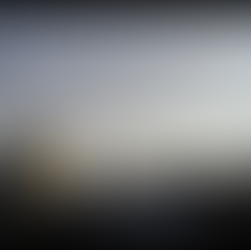




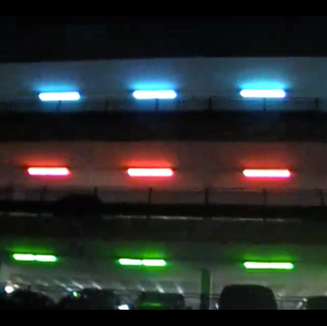


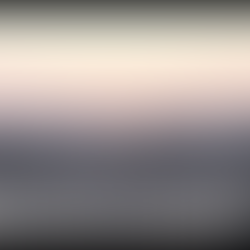



























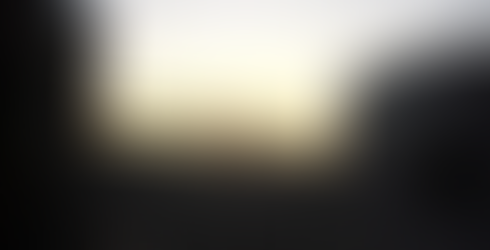












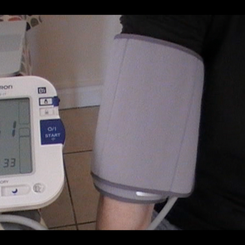



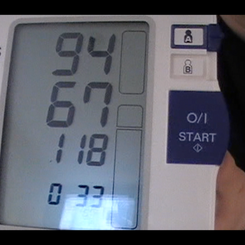









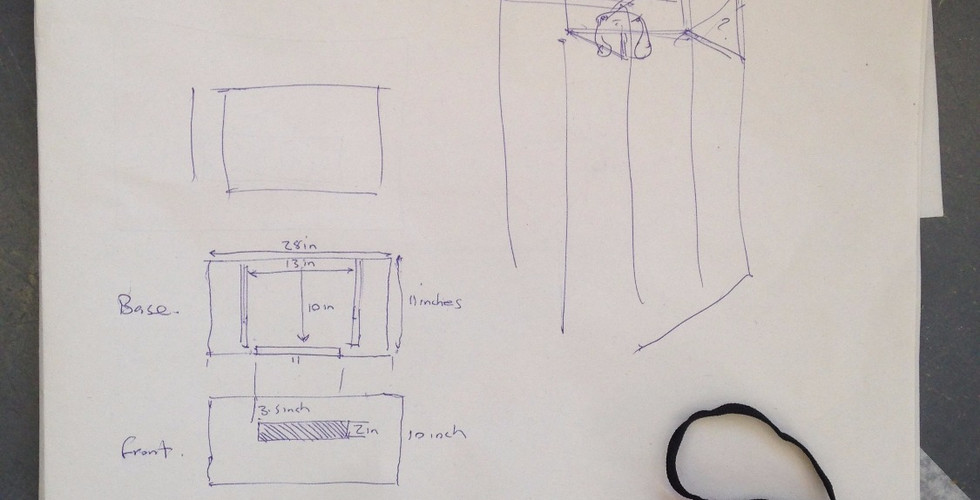


Comments